英语词汇学 Chapter1分析
- 格式:ppt
- 大小:145.00 KB
- 文档页数:29

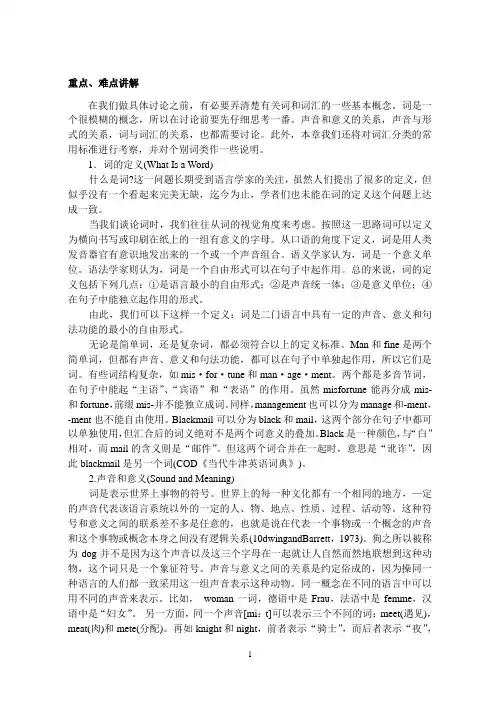
重点、难点讲解在我们做具体讨论之前,有必要弄清楚有关词和词汇的一些基本概念。
词是一个很模糊的概念,所以在讨论前要先仔细思考一番。
声音和意义的关系,声音与形式的关系,词与词汇的关系,也都需要讨论。
此外,本章我们还将对词汇分类的常用标准进行考察,并对个别词类作一些说明。
1.词的定义(What Is a Word)什么是词?这一问题长期受到语言学家的关注,虽然人们提出了很多的定义,但似乎没有一个看起来完美无缺,迄今为止,学者们也未能在词的定义这个问题上达成一致。
当我们谈论词时,我们往往从词的视觉角度来考虑。
按照这一思路词可以定义为横向书写或印刷在纸上的一组有意义的字母。
从口语的角度下定义,词是用人类发音器官有意识地发出来的一个或一个声音组合。
语义学家认为,词是一个意义单位。
语法学家则认为,词是一个自由形式可以在句子中起作用。
总的来说,词的定义包括下列几点:①是语言最小的自由形式;②是声音统一体;③是意义单位;④在句子中能独立起作用的形式。
由此,我们可以下这样一个定义:词是二门语言中具有一定的声音、意义和句法功能的最小的自由形式。
无论是简单词,还是复杂词,都必须符合以上的定义标准。
Man和fine是两个简单词,但都有声音、意义和句法功能,都可以在句子中单独起作用,所以它们是词。
有些词结构复杂,如mis·for·tune和man·age·ment。
两个都是多音节词,在句子中能起“主语”、“宾语”和“表语”的作用。
虽然misfortune能再分成mis-和fortune,前缀mis-并不能独立成词。
同样,management也可以分为manage和-ment,-ment也不能自由使用。
Blackmail可以分为black和mail,这两个部分在句子中都可以单独使用,但汇合后的词义绝对不是两个词意义的叠加。
Black是一种颜色,与“白”相对,而mail的含义则是“邮件”。
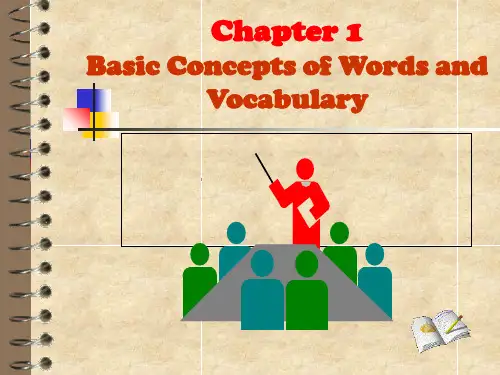
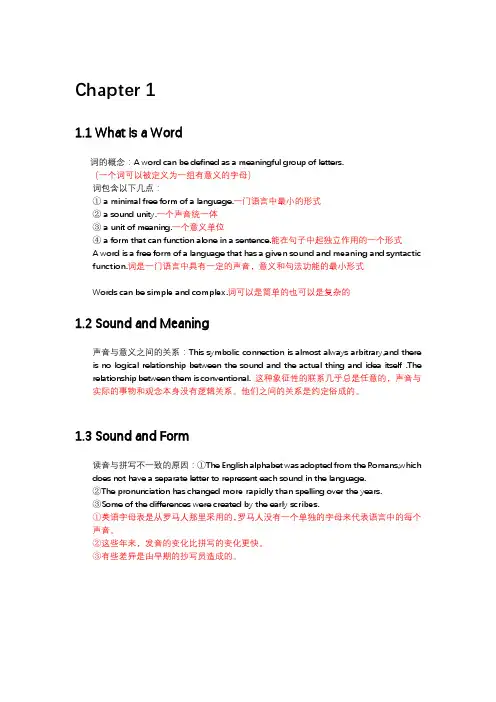
Chapter 11.1 What Is a Word词的概念:A word can be defined as a meaningful group of letters.(一个词可以被定义为一组有意义的字母)词包含以下几点:① a minimal free form of a language.一门语言中最小的形式② a sound unity.一个声音统一体③ a unit of meaning.一个意义单位④ a form that can function alone in a sentence.能在句子中起独立作用的一个形式A word is a free form of a language that has a given sound and meaning and syntacticfunction.词是一门语言中具有一定的声音,意义和句法功能的最小形式Words can be simple and complex.词可以是简单的也可以是复杂的1.2 Sound and Meaning声音与意义之间的关系:This symbolic connection is almost always arbitrary,and there is no logical relationship between the sound and the actual thing and idea itself .The relationship between them is conventional. 这种象征性的联系几乎总是任意的,声音与实际的事物和观念本身没有逻辑关系。
他们之间的关系是约定俗成的。
1.3 Sound and Form读音与拼写不一致的原因:①The English alphabet was adopted from the Romans,which does not have a separate letter to represent each sound in the language.②The pronunciation has changed more rapidly than spelling over the years.③Some of the differences were created by the early scribes.①英语字母表是从罗马人那里采用的,罗马人没有一个单独的字母来代表语言中的每个声音。
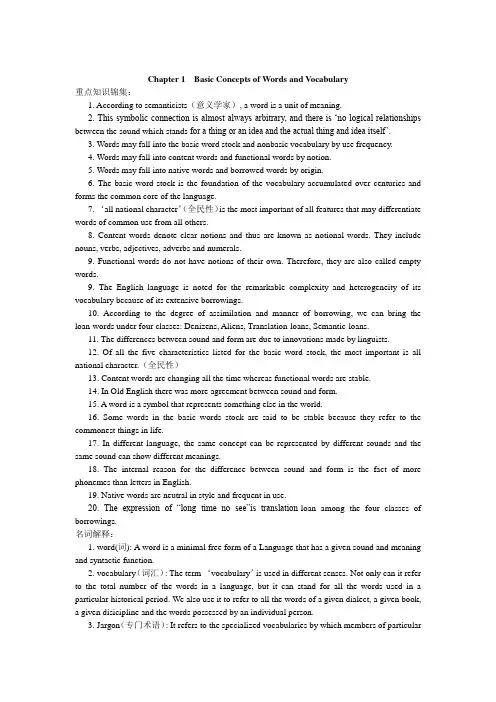
Chapter 1 Basic Concepts of Words and Vocabulary重点知识锦集:1. According to semanticists(意义学家), a word is a unit of meaning.2. This symbolic connection is almost always arbitrary, and there is ‘no logical relationships between the sound which stands for a thing or an idea and the actual thing and idea itself’.3. Words may fall into the basic word stock and nonbasic vocabulary by use frequency.4. Words may fall into content words and functional words by notion.5. Words may fall into native words and borrowed words by origin.6. The basic word stock is the foundation of the vocabulary accumulated over centuries and forms the common core of the language.7. ‘all national character’(全民性)is the most important of all features that may differentiate words of common use from all others.8. Content words denote clear notions and thus are known as notional words. They include nouns, verbs, adjectives, adverbs and numerals.9. Functional words do not have notions of their own. Therefore, they are also called empty words.9. The English language is noted for the remarkable complexity and heterogeneity of its vocabulary because of its extensive borrowings.10. According to the degree of assimilation and manner of borrowing, we can bring the loan-words under four classes: Denizens, Aliens, Translation-loans, Semantic-loans.11. The differences between sound and form are due to innovations made by linguists.12. Of all the five characteristics listed for the basic word stock, the most important is all national character.(全民性)13. Content words are changing all the time whereas functional words are stable.14. In Old English there was more agreement between sound and form.15. A word is a symbol that represents something else in the world.16. Some words in the basic words stock are said to be stable because they refer to the commonest things in life.17. In different language, the same concept can be represented by different sounds and the same sound can show different meanings.18. The internal reason for the difference between sound and form is the fact of more phonemes than letters in English.19. Native words are neutral in style and frequent in use.20. The expression of “long time no see”is translation-loan among the four classes of borrowings.名词解释:1. word(词): A word is a minimal free form of a Language that has a given sound and meaning and syntactic function.2. vocabulary(词汇): The term ‘vocabulary’is used in different senses. Not only can it refer to the total number of the words in a language, but it can stand for all the words used in a particular historical period. We also use it to refer to all the words of a given dialect, a given book,a given disicipline and the words possessed by an individual person.3. Jargon(专门术语): It refers to the specialized vocabularies by which members of particulararts, sciences, trades, and professions, communicate among themselves.4.Archaisms(古语词): Archaisms are words or forms that were once in common use but are now restricted only to specialized or limited use.5. Neologisms(新词语): Neologisms are newly created words or expressions, or words that have taken on new meanings.6. borrowed words(外来词): Words taken over from foreign languages are known as borrowed words or loan words or borrowings in simple terms.7. Deizens(同化词): Deizens are words borrowed early in the past and now are all assimilated into the English Language.8. Aliens(非同化词): Aliens are borrowed words which have retained their original pronunciation and spelling. These words are immediately recognisable as foreign in origin.9. Translation-loans(译借词): Translation-loans are words and expressions formed from the existing material in the English language but modelled on the patterns taken from another language.10.Semantic-loans(借义词): Words of this category are not borrowed with reference to the form. But their meanings are borrowed. In other words, English has borrowed a new meaning for an existing word in the language11. argot(黑话): It generally refers to the jargon of criminals.12. content words(实词): Content words denote clear notions including nouns, verbs, adjectives, adverbs and numerals.13. terminology(术语): Terminology consists of technical terms used in particular disciplines and academic areas.14. native words(本族语): Native words, also known as Anglo-Saxon words, are words brought to Britain in the 5th century by the German tribes.论述问答题:1. With the development of the Language, why do more and more differences occur between the Sound and Form?答:It is generally agreed that the written form of a natural Language is the written record of the oral form. But with the development of the Language, more and more differences occur between them, the reasons are as follows:①. The internal reason for this is that the English alphabet was adopted from the Romans, which does not have a separate letter to represent each sound in the Language so that some letters must do double duty or work together in combination.②. Another reason is that the pronunciation has changed more rapidly than spelling over the years, and in some cases the two have drawn far apart.③. A third reason is that some of the differences were created by the early scribes.④. Finally comes the borrowing, which is an important channel of enriching the English vocabulary. When English borrowed words from other Languages , it borrowed spelling as well.2. What are the obvious characteristics of the words of the basic word stock(基本词汇)?①. All national character.(全民性)②. Stability(稳定性)③. Productivity(多产性)④. Polysemy(多义性)⑤. Collocability(搭配性)Of course, not all the words of the basic word stock have these characteristics. Pronouns and numerals enjoy nation-wide use and stability, but are semantically monosemous and have limited productivity and collocability. Therefore, ‘all national character’is the most important of all features that may differentiate words of common use from all others.3. Apart from the characteristics mentioned of the basic word stock, in contrast to borrowed words, native words have two other features, what are they?答:①. Neutral in style(文体上中性). Since native words denote the commonest things in human society, they are used by all people, in all places, on all occasions, and at all times. Therefore, they are not stylistically specific.②. Frequent in use(使用频繁). Native words are most frequently used in everyday speech and writing. The proportion of its use in relation to borrowings is perhaps just the opposite of its number.4. Illustrate the relationship between sound and meaning with examples.答:A word is phonetic symbol that stands for something in the world. This symbolic connection is almost always arbitrary, and there is ‘no logical relationships between the sound which stands for a things or an idea and the actual thing and idea itself’. For example, woman is represented by the sound Frau in German, femme in French, and funv in Chinese.5. Explain neologisms(新词语)with examples.答:Neologisms are newly created words or expressions, or words that have taken on new meanings. For example, “emil”(electronic mail, the sending of messages via computer systems) is a word newly coined against the background of rapid development in information technology. The word “mouse” might examplify the words taking on new meanings : now a mouse is indispensable for computer users.6. How are English words generally classified? Elaborate on it.答:V ocabulary can be classified by different criteria into different types.①By use frequency(使用频率), words may fall into the basic word stock(基本词汇)and nonbasic vocabulary(非基本词汇). Basic vocabulary is small in number but forms the core of the language and enjoys the high frequency of use. Nonbasic vocabulary contains such words as terminology, jargon, which have a relatively limited use;②By notion(实义), words can be divided into content words(实义词)and functional words (功能词即虚词), content words have clear notions such as nouns, verbs. Functional words cover prepositions, articles, conjunctions, etc, whose major functions are to help make sentences;③By origin(起源), words can be grouped into native words(本族语词)and borrowed words (外来语词). Native words refer to the words of Anglo-Saxon origin, which are small in number but form the main stream of basic word stock. Borrowed words are words taken over from other languages and make up 80%of the whole English vocabulary. These three criteria are the most widespread and popular. There are other ways too, for example, by morphological structure, formality, emotionality, and so on.Chapter 2 The Development of the English Vocabulary重点知识锦集:1. Indo-European Language is made up of most of the Languages of Europe, the Near East, and India.2. The Germanic family consists of the four Northern European Languages:Norwegian, Icelandic, Danish and Swedish, which are generally known as Scandinavian Languages.3. In the Western set, Greek is the modern language derived from Hellenic.4. The surviving Languages show various of degrees of similarity to one another. The similarity bears a more or less direct relationship to their geographical distribution.5. Now people generally refer to Anglo-Saxon as Old English(古英语).6. The introduction of Christianity(基督教)at the end of the 6th century had a great impact on the English vocabulary.7. Old English (古英语)has a vocabulary of about 50,000 to 60,000 words. It was a highly inflected language just like modren German.8. Until 1066, although there were borrowings from Latin, the influence on English was mainly Germanic.9. The Norman Conquest started a continual flow of French words into English.10. During the Middle English period, Britain had trade relations with the low countries, especially Holland.11. Middle English retained much fewer inflections. If we say that Old English was a language of full endings, Middle English was one of leveled endings.12. As a result, Celtic made only a small contribution to the English vocabulary with such words as crag and bin and a number of place names like Avon, Kent, London, and Thames.13. After the invading Germanic tribes settled down in Britain, their Language almost totally blotted out Celtic .14. Old English is considered to be a highly-inflected Language.15. During the Middle English period three languages—English, French and Latin(英语,法语和拉丁语)---- existed simultaneously for over a century.16. Modern English(当代英语)began with the establishment of printing(印刷术)in England.17. Since the beginning of this century, word-formation has become even more important for the expansion of English vocabulary.18. Early Modern English refers to the language spoken from 1500 to 1700 .19. The major factors that promote the growth of modern English are the growth of science and technology, economic and political changes, the influence of other cultures and Languages .20. The four major foreign contributors to the English vocabulary in earlier times were French, Latin, Greek and Scandinavian .21. Though still at work today , borrowing can hardly compare with what it was in the past.22. It can be concluded that English has evolved from a synthetic Language(Old English) to the present analytic Language.23. Modern English vocabulary develops through three channels: creation, semantic change, borrowing.24. The word of “recollection” is formed by creation.25. The first people known to inhabit the British isles were Celts. Their languages were Celtic.26. Besides French words, English also absorbed as many as 2,500 words of Dutch origin in theMiddle English period.名词解释:1. creation(创造新词): Creation refers to the formation of new words by using the existing materials, namely roots, affixes and other elements. In Modern times, creation is the most important way of vocabulary expansion.2. semantic change(旧词新意): Semantic change means an old form which takes on a new meaning to meet the new need.3. borrowing(借用外来词语): Borrowing has played a vital role in the development of vocabulary, particularly in earlier times.4. Old English(古英语): It refers to the Language used from 450 to 1150.5. Middle English(中世纪英语): It refers to the Language used from 1150 to 1500.6. Modern English(现代英语): It refers to the Language used from 1500 up to the present.论述问答题:1. What are eight principal language in the Indo-European Language family(印欧语系)?答:They are Balto-Slavic, Indo-Iranian, Armenian, Albanian, Celtic, Italic, Hellenic and Germanic.2. What are the causes of more new words appearing today?答:the rapid development of modern science and technology.;Social, economic and political changes.;The influences of other cultures and languages.;3. What are three main modes of vocabulary developments?答:Creation creates new words by using existing materials.Semantic change. An old form takes on a new meaning to meet the new need.Borrow words from other Languages.Chapter 3 Word Formation I重点知识锦集:1. It seems to be generally agreed that a word is the smallest unit of a Language that stands alone to communicate meaning.2. In other words, the morpheme is ‘the smallest functioning unit in the composition of words’.3. Morphemes are abstract units, which are realized in speech by discrete units known as morphs.4. The morpheme to the morph what a phoneme is to a phone.5. Allomorphs as such do not occur at random, but are phonetically conditioned and thus predictable.6. Morphemes can be divided into free morphemes and bound morphemes.7. Bound morphemes are chiefly found in derived words.8. Bound morphemes include two types: bound root and affix.9. According to the functions of affixes, we can put them into two groups: inflectional affixes and derivational affixes.(内部曲折词缀和派生词缀)10. A monomorphemic word is a word that consists of a single free morpheme.11. Chiefly found in derived words, bound morphemes(黏着语素) include bound roots, inflectional affixes, derivational affixes.12. The plural morpheme ‘s’ is realized by /s/ after the sounds /t, p, k/ and by /z/ after /d, b, g, l/13. In the Eastern Set, Albanian and Armenian are each the only modern language respectively.名词解释:1. morpheme(语素): the minimal meaningful units are known as morphemes.2. allomorphs(语素变体): some morphemes, however, are realized by more than one morph according to their position in a word. Such alternative morphs are known as allomorphs.3. free morphemes(自由语素): Morphemes which are independent of other morphemes are considered to be free. These morphemes have complete meanings in themselves and can be used as free grammatical units in sentences.4. bound morphemes(黏着语素): morphemes which can not occur as separate words are bound. They are so named because they are bound to other morphemes to form words.5. bound root(黏着词根): a bound root is that part of the word that carries the fundamental meaning just like a free root. It’s a bound form and has to combine with other morphemes to make words.6. affixes(词缀): Affixes are forms that are attached to words or words elements to modify meaning or function.7. inflectional affixes(曲折词缀): Affixes attached to the end of words to indicate grammatical relationships are inflectional, thus known as inflectional morphemes.8. derivational affixes(派生词缀): As the term indicates, derivational affixes are affixes added to other morphemes to creat new words. Derivational affixes can be further divided into prefixes and suffixes.9. root(词根): A root is the basic form of a word which can not be further analysed without total loss of identity. It is that part of a word form that remains when all inflectional and derivational affixes have been removed.10. stem(词干): A stem can be defined as a form to which affixes of any kind can be added.论述问答题:1. What are the differences between root and stem?答:①A root is the basic form of a word which can not be further analysed without total loss of identity. The root whether free or bound generally carries the main component of meaning in a word.②A stem may consist of a single root morpheme as in “iron”or of two root morphemes as ina compound like “handcuff”. It can be a root morpheme plus one or more affixational morphemes as in “mouthful”. Therefore, a stem can be defined as a form to which affixes of any kind cab be added.2. Analyze the morphological structure of the following words in terms of free morpheme and bound morpheme, then explain the differences between the two kinds of morphemes.UnhappilyIdealistic答:①Each of two words consists of three morphemes:unhappily(un+happy+ly), idealistic(ideal+ist+ic).②“happy”and “ideal”are free morphemes; un-, -ly, -ist and –ic are bound morphemes.③free morphemes have complete meanings in themselves and can be used as free grammatical units in sentences. Bound morphemes must be bound to other morphemes to form words.3. Analyze the morphological structures of the following words and point out types of the morphemes. recollection, nationalist, unearthly.答:recollection, nationalist, unearthly1) Each of the three words consists of three morphemes:recollection(re+collect+ion), nationalist(nation+al+ist), unearthly(un+earth+ly).2) Of the nine morphemes, only “collect” “nation” and “earth” are free morphemes as they can exist by themselves.3) All the rest are bound morphemes as none of them can stand alone as words.Chapter 4 Word Formation II重点知识锦集:1. The expansion of vocabulary in modern English depends chiefly on word-formation.2. According to the positions which affixes occupy in words, affixes falls into two subclasses:prefixation and suffixation.(前缀和后缀)3. Affixation is also known as derivation.4. Prefixes do not generally change the word-class of the stem but only modify its meaning.5. Suffixes have only a small semantic role, their primary function being to change the grammatical function of stems. In other words, they mainly change the word class.6. We shall group suffixes on a grammatical basis into noun suffixes, verb suffixes, adjective suffixes, etc.7. Compounds can be written solid, hyphenated and open.(连写的,加连字符号的,不连写的)8. Most compounds consist of only two stems but are formed on a rich variety of patterns and the internal grammatical relationships within the words are considerably complex.9. Conversion is also known as functional shift.(功能转换)10. Words produced by conversion are primarily nouns, adjectives, and verbs.11. The most productive, however, is the conversion that takes place between nouns and verbs.12. Unlike verbs, not all adjectives which are converted can achieve a full noun status. Some are completely converted, thus known as full conversion,(完全转换)others are only partially converted, hence partial conversion.(部分转换)13. Blending(拼缀法)is a very productive process and many coinages resulting from blending have become well-established.14. As far as the structure is concerned, blends fall into four major groups: head+tail, head+head, head+word, word+tail.15. The overwhelming majority of blends are nouns.16. Blends are mostly used in writing related to science and technology, and to newspapers and magazines.17. There are four common types of clipping: front clipping, back clipping, front and back clipping, phrase clipping.18. Both intialisms and acronyms have become very popular since the Second World War and thus extremely productive.19. Words created through back-formation are mostly verbs.20. Stylistically, back-formed words are largely informal and some of them have not gained public acceptance.21. Open compounds look like free phrases as the elements forming each word are written separately.22. As a rule, the stress of compounds falls on the first element.23. A compound functions as a single grammatical unit, so the internal structure can not be changed.24. Conversion(转换法)refers to the use of words of one class as that of a different class.25. Partial conversion and full conversion are concerned with adjectives when converted to nouns.名词解释:1. affixation(词缀法): Affixation is generally defined as the formation of words by adding word-forming or derivational affixes to stems.2. prefixation(前缀法): Prefixation is the formation of new words by adding prefixes to stems.3. suffixation(后缀法): Suffixation is the formation of new words by adding suffixes to stems.4. compounding(合成法): Compounding, also called composition, is the formation of new words by joining two or more stems. Words formed in this way are called compounds.5. conversion(转换法): Conversion is the formation of new words by converting words of one class to another class.6. blending(拼缀法): Blending is the formation of new words by combining parts of two words or a word plus a part of another word. Words formed in this way are called blends or pormanteau words.7. clipping(截短法): Another common way of making a word is to shorten a longer word by cutting a part off the original and using what remains instead. This is called clipping.8. acronymy(首字母拼音法): Acronymy is the process of forming new words by joining the initial letters of names of social and political organizations or special noun phrases and technical terms.9. initialisms(首字母缩略词): Initialisms are words pronounced letter by letter.10. acronyms(首字母拼音词): Acronyms are words formed from initial letters but pronounced as a normal word.11. back-formation(逆生法): Back-formation is considered to be the opposite process of suffixation. It’s therefore the method of creating words by removing the supposed suffixes.论述问答题:1. In what aspects do compounds differ from free phrases?答:Compounds differ from free phrases in the following three aspects:1). Phonetic features. In compounds the word stress usually occurs on the first element whereas in noun phrases the second element is generally stressed if there is only one stress.2). Semantic features. Compounds are different from free phrases in semantic unity. Every compound should express a single idea just as one word.3). Grammatical features. A compound tends to play a single grammatical role in a sentence, for example, a verb, a noun, or an adjective.2. What is the best way to classify prefixes? Why?答:Prefixes do not usually change the word-class of the stem but only modify lts meaning.Although present-day English finds an increasing number of class-changing prefixes, they make up only an insignificant number in the huge contemporary vocabulary. It might be the best way to classify prefixes by their non-class-changing feature.3. In what way are compound verbs generally formed? Give examples to illustrate your point.答:Compound verbs are created either through conversion or back-formation. This could be illustrated by two words, nickname and chain-smoker. Nickname, which is originally a noun, can be used as a verb through conversion. Chain-smoker, which is originally a noun, can turn into a verb through back-formation.4. What is the difference between partial and full conversion? Explain them with examples. 答:When converted to nouns, not all adjectives can achieve a full noun status. Some are completely converted, thus known as full conversion, others are only partially converted, hence partial conversion. When a noun fully converted from an adjective has all the characteristics of a noun, it can take an indefinite article or-(e)s to indicate singular or plural number. For example, adjective “white”can be fully converted to a noun “white”, which can take indefinite article: a white. When a noun partially converted from adjectives do not possess all the qualities a noun does. They must be used together with the definite article, and they retain some of the adjective features. For example, the poor, the rich.5. Both back-formation(逆生法)and back-clipping(截后留前)are ways of making words by removing the endings of words. How do you account for the coexistence of the two? Can you explain the difference?答:Back-formation is the method of creating words by removing the supposed suffixes. It’s considered to be the opposite process of suffixation. For example, “loafer”may be assumed to derive from the verb “loaf”’on the analogy of known derivatives, such as “swimmer” from “swim” or “driver” from “drive”. By removing the supposed suffixes –er from “loafer”, a verb “loaf”’is coined. Majority of back-formed words are verbs. Back-clipping is different. The deletion occurs at the end of the word(usually a noun). Both the original long word and its short form remain in the same word class. In diffe rent context, one could be used in other’s place.6. After he comes back, he oiled machine.In above sentence, which word is the converted word? Explain the type of the conversion and the effect of the conversion.答:In this sentence, the word “oil”is the converted word. It is converted from a noun to a verb. When it was used as a noun, the meaning of it is that “油”. But in this sentence, it was used as a verb, the meaning is “给…加油”; As is often the case, a noun can be converted to a verb without any change. The use of the verb converted is both economical and vivid.Chapter 5 Word Meaning重点知识锦集:1. Reference(所指关系) is the relationship between Language and the world.2. The reference of a word to a thing outside the Language is arbitrary and conventional.(任意的和依照惯例的)3. Although reference is a kind of abstraction, yet with the help of context, it can refer tosomething specific.4. Every word that has meaning has sense(not every word has reference).5. Different lexical items, which have different lexical meanings, may have the same grammatical meaning.(语法意义)6. Functional words, though having little lexical meaning, possess strong grammatical meaning.7. Lexical meaning itself has two components: conceptual meaning and associative meaning.(概念意义和关联意义)8. Associative meaning(关联意义)comprises four types: connotative, stylistic, affective, collocative.9. Words that have emotive values may fall into two categories: appreciative or pejorative.(褒义词和贬义词)10. To a large extent the affective meaning of the word depends on the context where the word is used.11. Motivation(理据)explains why a particular form has a particular meaning.12. Unlike conceptual meaning, associative meaning is unstable and indeterminate.13. By etymological motivation, we mean that the meaning of a particular word is related to its origin.14. The relationship between the linguistic sign and a referent is conventional.15. Content words have both meanings, and Lexical meaning(词汇意义)in particular.16. The word “miniskirt”is morphologically motivated.17. The word “laconic”is etymologically motivated.18. In the phrase “the mouth of the river”, the word “mouth”is semantically motivated.名词解释:1. concept(概念): Concept, which is beyond Language, is the result of human cognition, reflecting the objective world in the human mind. It’s universal to all men alike regardless of culture, race, Language and so on.2. sense(语义): Sense denotes the relationship inside the Language. The sense of an expression is its place in a system of semantic relationships with other expressions in the Language.3. motivation(理据): Motivation accounts for the connection between the linguistic symbol and its meaning.4. onomatopoeic motivation(拟声理据): In modern English one may find some words whose sounds suggest their meanings, for these words were created by imitating the natural sounds or noises. For example, bang, miaow, ha ha and the like are onomatopoetically motivated words. Knowing the sounds of the words means understanding the meaning.5. morphological motivation(形态理据): Compounds and derived words are multi-morphemic words and the meanings of many are the sum total of the morphemes combined. Quite often, if one knows the meaning of each morpheme, one can figure out the meaning of the word. For instance, “airmail” means to ‘mail by air’.6. semantic motivation(语义理据): Semantic motivation refers to the mental associations suggested by the conceptual meaning of a word. It explains the connection between the literal sense and figurative sense of the word.7. etymological motivation(词源学理据): The meanings of many words often relate directly。
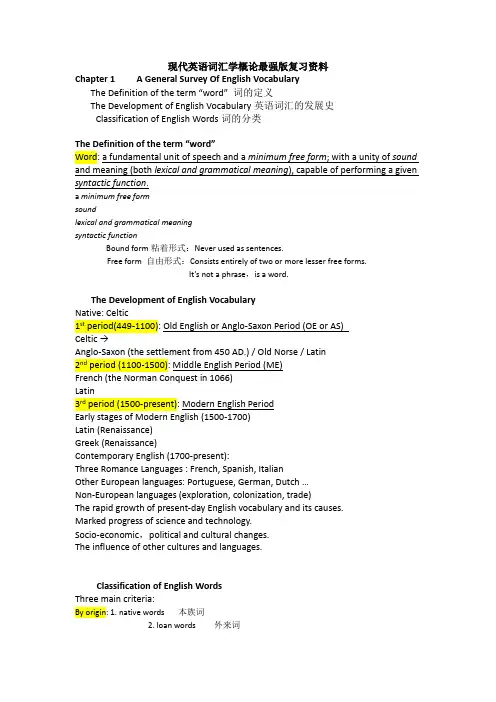
现代英语词汇学概论最强版复习资料Chapter 1 A General Survey Of English VocabularyThe Definition of the term “word” 词的定义The Development of English Vocabulary英语词汇的发展史Classification of English Words词的分类The Definition of the term “word”Word: a fundamental unit of speech and a minimum free form; with a unity of sound and meaning (both lexical and grammatical meaning), capable of performing a given syntactic function.a minimum free formsoundlexical and grammatical meaningsyntactic functionBound form粘着形式:Never used as sentences.Free form 自由形式:Consists entirely of two or more lesser free forms.It’s not a phrase,is a word.The Development of English VocabularyNative: Celtic1st period(449-1100): Old English or Anglo-Saxon Period (OE or AS)Celtic →Anglo-Saxon (the settlement from 450 AD.) / Old Norse / Latin2nd period (1100-1500): Middle English Period (ME)French (the Norman Conquest in 1066)Latin3rd period (1500-present): Modern English PeriodEarly stages of Modern English (1500-1700)Latin (Renaissance)Greek (Renaissance)Contemporary English (1700-present):Three Romance Languages : French, Spanish, ItalianOther European languages: Portuguese, German, Dutch …Non-European languages (exploration, colonization, trade)The rapid growth of present-day English vocabulary and its causes.Marked progress of science and technology.Socio-economic,political and cultural changes.The influence of other cultures and languages.Classification of English WordsThree main criteria:By origin: 1. native words 本族词2. loan words 外来词By level of usage: 1. common words 普通词2. literary words 书面词3. colloquial words 口头词4. slang words 俚语5. technical words 术语By notion: 1. function words 功能词2. content words 实义词By origin:1. native words 本族词2. loan words 外来词Native words: words of Anglo-Saxon origin or of old EnglishFeatures of native words:Most are monosyllabicforming the great majority of the basic word stockLoan / borrowed words: those borrowed from other languagesBasic word stock:auxiliary, modal verbs, numerals, pronouns, prepositions, conjunctions, the most frequently used words (essential to life)National characterStabilityWord-forming abilityAbility to form collocationsBy level of usage:1. Common words 普通词2. Literary words 书面词3. Colloquial words 口头词4. Slang words 俚语5. Technical words 术语*There are no clear-cut boundaries between the various classes of words.Common words普通词:connected with the ordinary things or activities necessary to everyday lifeThe core of the common words is the basic word stock.Stylistically neutralLiterary words书面词:chiefly used in writing, especially in books written in a more elevated style, in official documents, or in formal speeches.Most are of French, Latin or Greek origin.Among the literary word, two categories are noteworthy:archaic words . obsolete words)poetical wordsSlang俚语:Language, words or phrases of a vigorous, colorful, facetious, or taboo nature, invented for specific occasions, or uses or derived from the unconventional use of the standard vocabularyNot generally used in informal conversation unless the speakers are on intimate termsEmbracing those daring and new expression that have not been accepted as standard EnglishThe chief reason for use of slang: secure freshness and noveltyTechnical words术语:used in various fields: science, profession or trade, art, sportincreasing precision in nomenclatureone specific meaningLatin or Greek in originBy notion:1. function words 功能词2. content words 实义词Function words:determiners, conjunctions, prepositions, auxiliariesnot having much lexical meaningserving grammatically:Behaving like grammatical signals or functional markers,Expressing the kinds of connection between content wordsConstructing acceptable English sentencessmall in number and stable:In relatively closed listsBelonging to a relatively small and permanent set of words)high frequency。
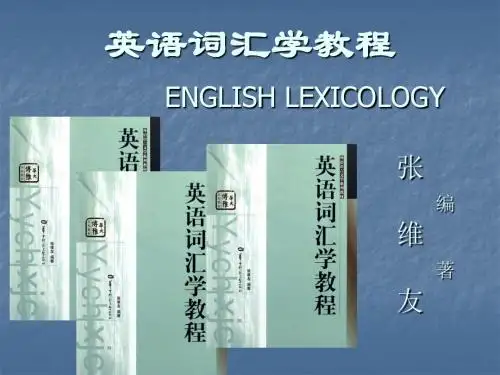
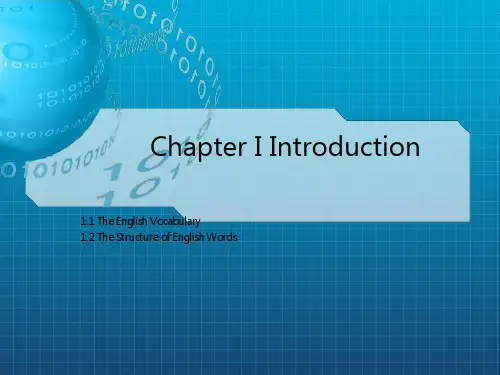
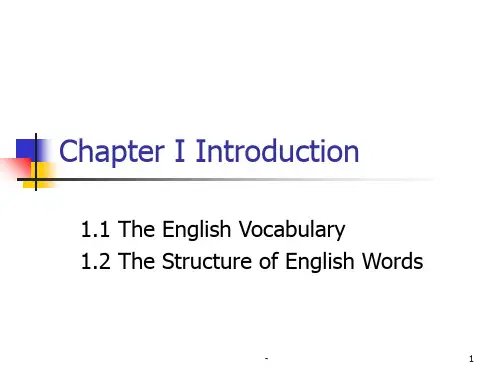

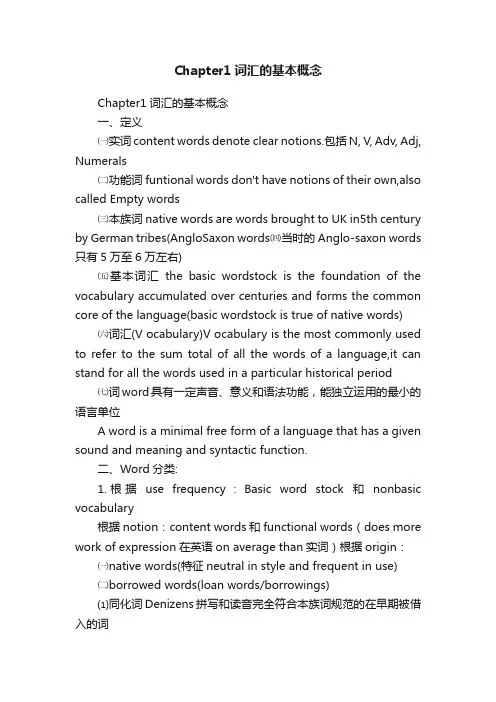
Chapter1词汇的基本概念Chapter1词汇的基本概念一、定义㈠实词content words denote clear notions.包括N, V, Adv, Adj, Numerals㈡功能词funtional words don't have notions of their own,also called Empty words㈢本族词native words are words brought to UK in5th century by German tribes(AngloSaxon words㈣当时的Anglo-saxon words 只有5万至6万左右)㈤基本词汇the basic wordstock is the foundation of the vocabulary accumulated over centuries and forms the common core of the language(basic wordstock is true of native words) ㈥词汇(V ocabulary)V ocabulary is the most commonly used to refer to the sum total of all the words of a language,it can stand for all the words used in a particular historical period ㈦词word具有一定声音、意义和语法功能,能独立运用的最小的语言单位A word is a minimal free form of a language that has a given sound and meaning and syntactic function.二、Word分类:1.根据use frequency:Basic word stock和nonbasic vocabulary根据notion:content words和functional words(does more work of expression在英语on average than实词)根据origin:㈠native words(特征neutral in style and frequent in use)㈡borrowed words(loan words/borrowings)⑴同化词Denizens拼写和读音完全符合本族词规范的在早期被借入的词Denizens are words borrowed early in the past and now are well assimilated into the english language⑵非同化词aliens保留起原来的发音和拼写Aliens are borrowed words which have retained their original pronunciation and spelling⑶译借词Translation-loans通过翻译引进的词Translation-loan are words and expressions formed from the exsiting material in the English language but modeled on the patterns taken from another language⑷借义词Semantic-loans借义不借词形English has borrowed a new meaning for an existing word in the language.2.根据使用位臵分类的特征:a全民性All national character(鉴别基本词汇的标准)b稳定性Stabilityc多产性Productivity d多义性Ploysemy e搭配性Collocability3.非基本词汇包括:Teminology术语slang俚语argot黑话jargon行话dialectal words方言archaisms古语词neologisms新词语三、问答㈠the internal reason of difference between sound and form⑴the internal reason for this’s that the English alphabet was adopted from Romans,which doesnot have a separate letter to represent each sound in the language,so that some letters mus do double duty or work together in combination⑵another reason is that the pronuncation has changed more rapidly than spelling over the years⑶some of the differences were created by the early scribs(i n the late1500,printing became well established)⑷lots of borrowings is an important channel of enrichingEnglish vocabulary.㈡how do you account for the role of Native W ords in English in relation to Loan-words⑴Native words are those of Anglo-saxon origin,which are small in number,Loan-words are borrowed from other language.⑵it’s estimated loan -words constitue about80%of the modern English vocabulary,native words canot compare with loan-words in number,but have a more important role in the language⑶na tive words form the mainstream of the basic word stock whereas only a limited number of borrowed words belong to the common core.㈢illustrate the relationship between sound and meaning⑴sound is the physical aspect of a word and meaning is what the sound refers to⑵sound and meaning are not intrinsically related and their connection is arbitary and conventionalChapter2.-3词汇的发展及构成Ⅰ一、定义1创新Creation refers to the formation of new words by using the existing materials,namely roots,affixes and other element 2语义变化semantic change means an old form which takes on a new meaning to meet the new need(在number and form 上无变化)3词素morpheme is the smallest functioning unit in the composition of words4词素变体allomorphs is one of the variants that realize a morpheme举例:如复数词素-s 在不同语境中有不同的形式:cats/s/,bags/z/和matches/iz/就是词素变体5复合词根bound root is a bound form and has to combiene with other morphemes to make words6词缀Affixes are forms that attached to words or word elements to modify meaning or function7曲折词缀Inflectional affixes(特点是small 和stable)it attached to the end of words to indicate grammatical relationship8派生词缀Derivational affixes added to other morphemes to creat new words二、要点1.印欧语系indo-european language family(Europe,the Near East,India)Balto-slavicPrussian, Lithuanian, Polish, Bulgarian, Slovenian, Russianlatin,Greek,French,San skrit 给英语的影响最大 ArmenianIndo-IranianHindi, Persian AlbanianCelticIrish, Scottish, Breton HellenicGreek GermanicNorwegian, Icelandic, Danish, Swedish, English, German Italic(Latin)Italian, Portuguese, Spanish, Roumanian, French 2.英语发展的三个阶段⑴old English (450-1150)当时大约有5---6万单词①the frist people known to inhahit the land 英国是celts,后来410年被Roman 征服② the 2nd major language known in England was the Latin of the Roman legions.③Now the people generally refer to Anglo-Saxon as Old English.④the end of6th century,the introduction of Christianity hada great impact on the English V ocabulary⑵Middle English(1150-1500)①Old English began to undergo a great change when Norman invaded England from France in1066,till then,although there were borrowings from Latin,the influence on english was mainly Germanic.当时大批法语被用于english,至今70%仍留用.②在13世纪末,英语才恢复为学校,法庭和官方语言另外old English was a language of full endings,middle English was one of leveled endings,in modern English,word endings were mostly lost with just a few exception,it can be concluded that english has evolved from a synthetic language to the present analytic language例如: old English Middle English Modern EnglishLeorn-ian Lern-en Learn⑶modern E nglish(1500till now)①modern english共分2个阶段1500-1700和1700至今②modern English began with the establishement of Priting in England③More than25%modern enlish words come almost from classical languages④although borrowing remained an important channel ofvocabulary expression,yet more words are created by means of word-formation3.Three reasons for the growth of modern English vocabulary①rapid development of modern science and technology②Political,social and economic changes③Contact with other languages and c ultures4.Modes of the development of modern English vocabulary①creation ②Semantic change ③borrowing(在英语的发展中起vital role)另外.Reviving archaic or obsolete words also contributes to the growth of English5.词的构成morphemeFree morpheme(free root)Bound morpheme(cant occur as separate words are bound) Those morphemes have complete meanings in themselves and can be used as freegrammatical units in setence有完整的形式和意义,可起一个词的作用Bound root affixIt is that partof the word thatcarries thefundamentalmeaning ,it has tocombine with othermorphemes to makewordsInflectional affixDerivational affixprefixsuffix三、问答区别Root and Stem1.a root is the basic form of a word which canot be further analysed without total loss of identity,whether free or bound root,generally carries the main component of meaning in a word2.a stem can be defined as a form to which affixes of any kind can be added3.a stem can replace root and also refer to any form which is larger than root.Chapter4 词汇的构成Ⅱ一、定义1.Afffixation is generally defined as the formation of words by adding word-forming or derivational affixes to stems.2.Prefixation is the formation of new words by adding prefixes to stems.it doesn’t change the word-class of the stem,but modify its meaning.3.Suffixation is the fo rmation of new words by adding suffixes to stems, it’s to change the grammatical functions of stems./doc/e914636537.html,pound is the formation of new words by joining tow or more stems words formed.5.Conversion is the formation of new words by converting words of one class to another class.词性变,拼写不变6.Zero-Derivation:Conversion is generally considered to be aderivational process whereby an item is adopted or converted to a new word class without the addition of an affix.派生过程,在这个过程中不断增加词缀而派出一个词就被转变成一个新词。
现代英语词汇学概论第一章汉语版
《现代英语词汇学概论》是英国语言学家约翰·西诺特(John Sinclair)所著,于1966年出版的一本关于英语词汇学的经典著作。
该
书第一章的主要内容涉及了词汇学研究的背景和目标。
第一章的汉语版主要包括以下内容:
1.引言:介绍了词汇学研究的重要性和目的,以及该书的结构和内容。
2.词汇学的起源和发展:回顾了词汇学研究的历史背景和不同阶段的
发展,包括传统历史语言学和现代语言学的贡献。
3.词汇研究的方法和工具:介绍了进行词汇学研究所需的方法和工具,包括词汇统计、语料库、词典和计算机技术的运用等。
4.词汇学的理论框架:探讨了几种主要的词汇学理论,包括认知语义学、联想语义学和构式语法等,并解释了它们在研究词汇结构、意义和使
用方面的作用。
5.词汇学的研究领域:概述了词汇学研究的不同领域,包括词汇结构、词汇意义、词汇使用和词汇变化等,并举例说明了不同领域的研究方法和
发现。
总之,第一章的汉语版主要介绍了词汇学研究的基本概念、方法和理
论框架,为后续章节的词汇学内容打下基础。